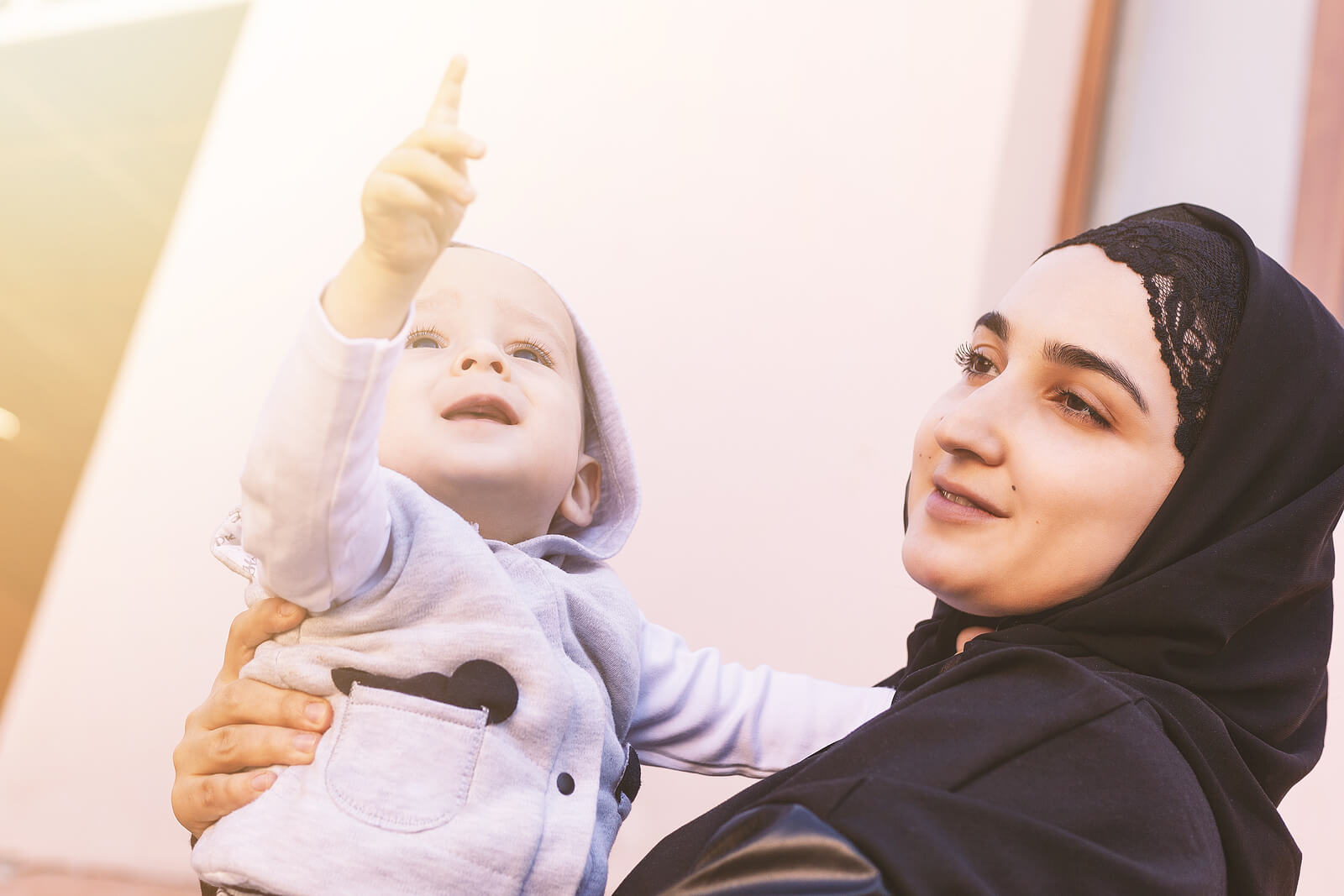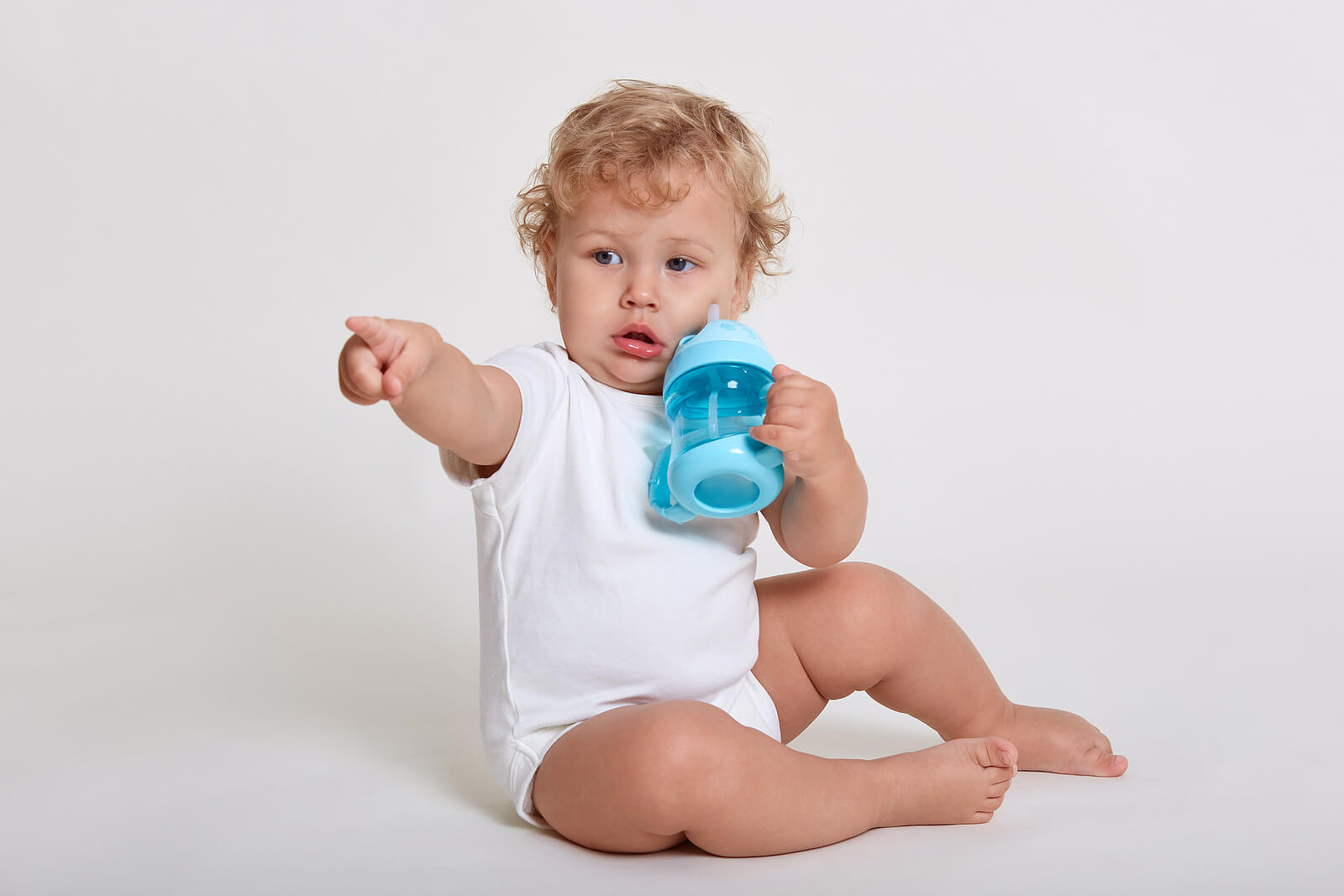What to Do if My Child Doesn't Point?


Written and verified by the psychologist Laura Ruiz Mitjana
Have you been noticing that your child doesn’t point to objects when they want to get or show you something? Instead, they take your hand and lead you to what they want to get. In the following lines, we’ll give you 5 ideas that will allow you to work with them on this behavior, which will help you to solve this issue.
In order to do this, it’s very important for the child to see that it’s a process of cause and effect; that is, that the moment they point to something (or you help them to point), they’ll get the desired object. In other words, they’ll have to establish the relationship between the pointing behavior and the consequence of the action (getting what they need or want).

The importance of joint attention
When children start pointing, they can do it for two reasons: To show you something or to get something. In the first case, we’re talking about a process called “joint attention,” which implies that the child and the adult share interest in the same object.
According to Butterworth (1991), cited in Escudero et al. (2013), joint attention is. “the ability to follow the direction of another’s gaze, or to look where someone else is looking.” This action will be very important to establish communicative turns, as well as the intention and desire to communicate.
What can you do if your child doesn’t point?
At what age should a child point? Some experts say that this behavior appears as early as 8 months and others say as early as 10 months. However, the range varies between these ages. In addition, as parents, we can facilitate the acquisition of this behavior to our children.
If the behavior doesn’t appear, we should consult a professional specialist, as it could be a warning sign for certain disorders such as autism spectrum disorder. Here are 5 ideas to start working!
Model their hand
Beatriz Maya, teacher and speech therapist, recommends this first tip that can help you if your child doesn’t point. So, when your child leads you by the hand to what they want or need (a phenomenon called “adult instrumentalization”), try to take their hand and help them acquire the necessary position to point. Practice this every time your child exhibits this behavior.
If your child doesn’t point, touch the object
Once you have their hand, with the correct pointing position, reach out to the object they want to get and touch it with their index finger. You can also try helping them hold this pointing position while you both touch the object. Then hand it to them.
Accompany the process with language
Another idea that can help you is to accompany the process with language. So, once you touch the object your child wanted to get, with your child’s index finger, say the word in question. For example, say: “car”, “table”, “doll”, etc.
You can try touching the object with your child’s index finger as many times as there are syllables in the word. This small gesture can help your child to consolidate the action and the word, but, like the previous steps, it should be repeated frequently.
Repeat the previous actions if your child doesn’t point
As we said, you should repeat these small actions so that your child gradually integrates them; do them every time you see that your child intends to point or when they approach you and take your hand to show you something. This is a way for your child to acquire and internalize the pointing behavior.

Increase the distance to the object
Once you’ve been repeating these actions, try increasing the “difficulty” of the action by progressively increasing the distance from which you point. At first, touch the object with it and, little by little, move away from it, while continuing to point with your finger. Do all this as the child understands the process and integrates the pointing action.
“To exert a beneficial influence among children, it’s indispensable to participate in their joys.”
-Don Bosco
In short, pointing is part of the child’s intentional communication, and encouraging its development will help us to accompany our child in their growth.
Therefore, according to a study by Escudero, Carranza and Huéscar (2013), communication comes from the need to maintain contact with the adult and is initially established from non-symbolic elements, such as joint attention and pointing.
In this sense, this behavior will appear naturally, if there’s no underlying neurodevelopmental disorder, but we can also help to enhance it through actions such as those mentioned above.
Have you been noticing that your child doesn’t point to objects when they want to get or show you something? Instead, they take your hand and lead you to what they want to get. In the following lines, we’ll give you 5 ideas that will allow you to work with them on this behavior, which will help you to solve this issue.
In order to do this, it’s very important for the child to see that it’s a process of cause and effect; that is, that the moment they point to something (or you help them to point), they’ll get the desired object. In other words, they’ll have to establish the relationship between the pointing behavior and the consequence of the action (getting what they need or want).

The importance of joint attention
When children start pointing, they can do it for two reasons: To show you something or to get something. In the first case, we’re talking about a process called “joint attention,” which implies that the child and the adult share interest in the same object.
According to Butterworth (1991), cited in Escudero et al. (2013), joint attention is. “the ability to follow the direction of another’s gaze, or to look where someone else is looking.” This action will be very important to establish communicative turns, as well as the intention and desire to communicate.
What can you do if your child doesn’t point?
At what age should a child point? Some experts say that this behavior appears as early as 8 months and others say as early as 10 months. However, the range varies between these ages. In addition, as parents, we can facilitate the acquisition of this behavior to our children.
If the behavior doesn’t appear, we should consult a professional specialist, as it could be a warning sign for certain disorders such as autism spectrum disorder. Here are 5 ideas to start working!
Model their hand
Beatriz Maya, teacher and speech therapist, recommends this first tip that can help you if your child doesn’t point. So, when your child leads you by the hand to what they want or need (a phenomenon called “adult instrumentalization”), try to take their hand and help them acquire the necessary position to point. Practice this every time your child exhibits this behavior.
If your child doesn’t point, touch the object
Once you have their hand, with the correct pointing position, reach out to the object they want to get and touch it with their index finger. You can also try helping them hold this pointing position while you both touch the object. Then hand it to them.
Accompany the process with language
Another idea that can help you is to accompany the process with language. So, once you touch the object your child wanted to get, with your child’s index finger, say the word in question. For example, say: “car”, “table”, “doll”, etc.
You can try touching the object with your child’s index finger as many times as there are syllables in the word. This small gesture can help your child to consolidate the action and the word, but, like the previous steps, it should be repeated frequently.
Repeat the previous actions if your child doesn’t point
As we said, you should repeat these small actions so that your child gradually integrates them; do them every time you see that your child intends to point or when they approach you and take your hand to show you something. This is a way for your child to acquire and internalize the pointing behavior.

Increase the distance to the object
Once you’ve been repeating these actions, try increasing the “difficulty” of the action by progressively increasing the distance from which you point. At first, touch the object with it and, little by little, move away from it, while continuing to point with your finger. Do all this as the child understands the process and integrates the pointing action.
“To exert a beneficial influence among children, it’s indispensable to participate in their joys.”
-Don Bosco
In short, pointing is part of the child’s intentional communication, and encouraging its development will help us to accompany our child in their growth.
Therefore, according to a study by Escudero, Carranza and Huéscar (2013), communication comes from the need to maintain contact with the adult and is initially established from non-symbolic elements, such as joint attention and pointing.
In this sense, this behavior will appear naturally, if there’s no underlying neurodevelopmental disorder, but we can also help to enhance it through actions such as those mentioned above.
All cited sources were thoroughly reviewed by our team to ensure their quality, reliability, currency, and validity. The bibliography of this article was considered reliable and of academic or scientific accuracy.
- Bakeman, R. y Adamson, L.B. (1984). Co-ordinating attention to people and objects in mother-infant and peer-infant interaction. Child Development, 55: 1278-1289.
- Butterworth, G. y Jarrett, N. (1991). What minds have in common is space: Spatial mechanisms serving joint visual attention in infancy. British Journal of Developmental Psychology, 9: 55-72.
- Enesco, I. (Coord.). (2003). El desarrollo del bebé: cognición, emoción y afectividad. Madrid: Alianza.
- Escudero-Sanz, A., Carranza-Carnicero, J.A. & Huéscar-Hernández, E. (2013). Aparición y desarrollo de la atención conjunta en la infancia. Anales de Psicología, 29(2): 404-412.
This text is provided for informational purposes only and does not replace consultation with a professional. If in doubt, consult your specialist.








